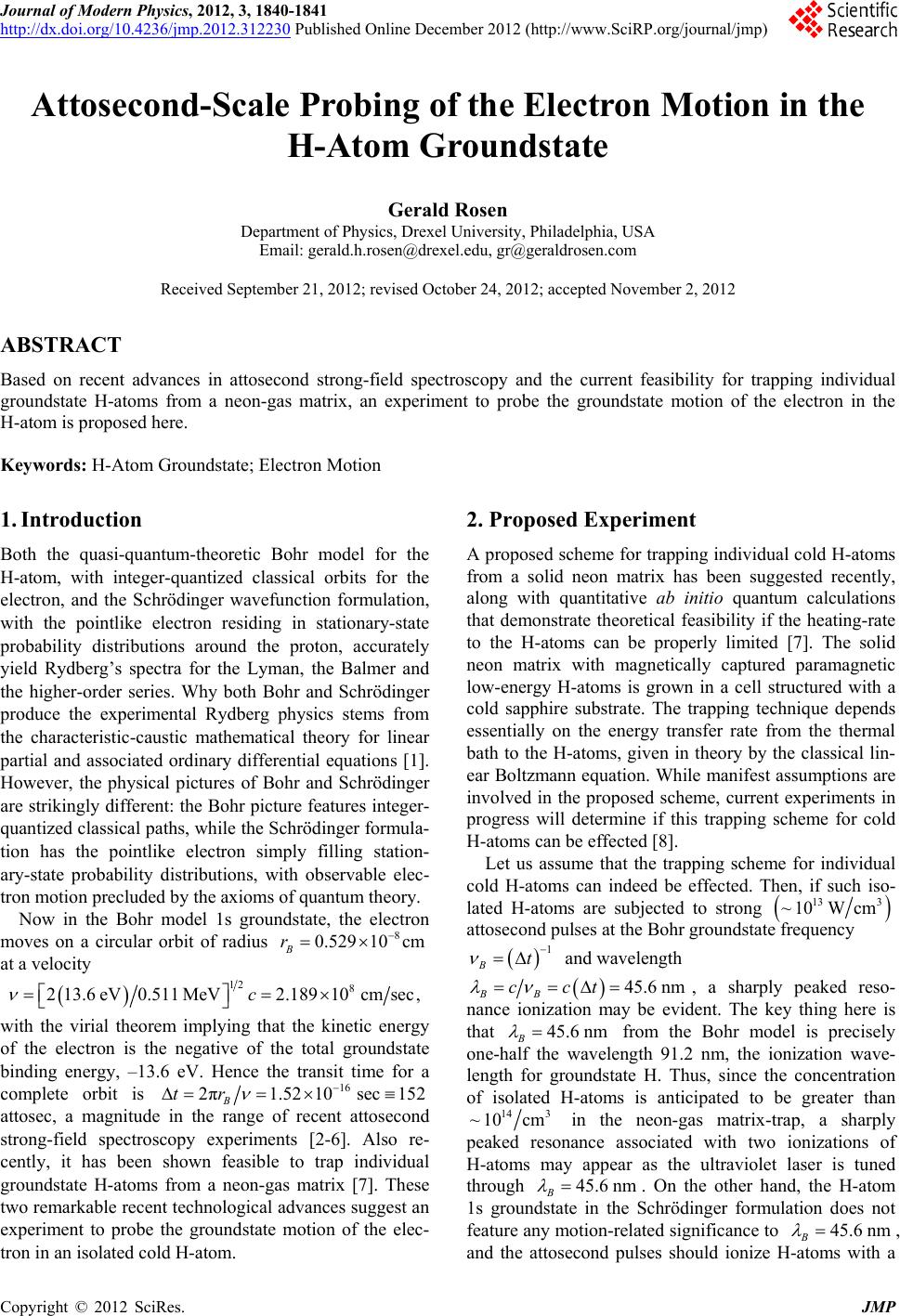
Journal of Modern Physics, 2012, 3, 1840-1841
http://dx.doi.org/10.4236/jmp.2012.312230 Published Online December 2012 (http://www.SciRP.org/journal/jmp)
Attosecond-Scale Probing of the Electro n Motion in the
H-Atom Groundstate
Gerald Rosen
Department of Physics, Drexel University, Philadelphia, USA
Email: gerald.h.rosen@drexel.edu, gr@geraldrosen.com
Received September 21, 2012; revised October 24, 2012; accepted November 2, 2012
ABSTRACT
Based on recent advances in attosecond strong-field spectroscopy and the current feasibility for trapping individual
groundstate H-atoms from a neon-gas matrix, an experiment to probe the groundstate motion of the electron in the
H-atom is proposed here.
Keywords: H-Atom Groundstate; Electron Motion
1. Introduction
Both the quasi-quantum-theoretic Bohr model for the
H-atom, with integer-quantized classical orbits for the
electron, and the Schrödinger wavefunction formulation,
with the pointlike electron residing in stationary-state
probability distributions around the proton, accurately
yield Rydberg’s spectra for the Lyman, the Balmer and
the higher-order series. Why both Bohr and Schrödinger
produce the experimental Rydberg physics stems from
the characteristic-caustic mathematical theory for linear
partial and associated ordinary differential equations [1].
However, the physical pictures of Bohr and Schrödinger
are strikingly different: the Bohr picture features integer-
quantized classical paths, while the Schrödinger formula-
tion has the pointlike electron simply filling station-
ary-state probability distributions, with observable elec-
tron motion precluded by the axioms of quantum theory.
Now in the Bohr model 1s groundstate, the electron
moves on a circular orbit of radius
at a velocity
8
.529 10cm
0
B
r
12 8
213.6eV0.511 MeV2.18910cmsec,c
with the virial theorem implying that the kinetic energy
of the electron is the negative of the total groundstate
binding energy, –13.6 eV. Hence the transit time for a
complete orbit is
2. Proposed Experiment
A proposed scheme for trapping individual cold H-atoms
from a solid neon matrix has been suggested recently,
along with quantitative ab initio quantum calculations
that demonstrate theoretical feasibility if the heating-rate
to the H-atoms can be properly limited [7]. The solid
neon matrix with magnetically captured paramagnetic
low-energy H-atoms is grown in a cell structured with a
cold sapphire substrate. The trapping technique depends
essentially on the energy transfer rate from the thermal
bath to the H-atoms, given in theory by the classical lin-
ear Boltzmann equation. While manifest assumptions are
involved in the proposed scheme, current experiments in
progress will determine if this trapping scheme for cold
H-atoms can be effected [8].
Let us assume that the trapping scheme for individual
cold H-atoms can indeed be effected. Then, if such iso-
lated H-atoms are subjected to strong
13 3
~10W cm
1
Bt
attosecond pulses at the Bohr groundstate frequency
and wavelength
45.6 nmcct
45.6nm
BB , a sharply peaked reso-
nance ionization may be evident. The key thing here is
that B
from the Bohr model is precisely
one-half the wavelength 91.2 nm, the ionization wave-
length for groundstate H. Thus, since the concentration
of isolated H-atoms is anticipated to be greater than
16
2π1.52 10sec152tr
B
attosec, a magnitude in the range of recent attosecond
strong-field spectroscopy experiments [2-6]. Also re-
cently, it has been shown feasible to trap individual
groundstate H-atoms from a neon-gas matrix [7]. These
two remarkable recent technological advances suggest an
experiment to probe the groundstate motion of the elec-
tron in an isolated cold H-atom.
14 3
~10 cm
45.6nm
in the neon-gas matrix-trap, a sharply
peaked resonance associated with two ionizations of
H-atoms may appear as the ultraviolet laser is tuned
through B
. On the other hand, the H-atom
1s groundstate in the Schrödinger formulation does not
feature any motion-related significance to B45.6 nm
,
and the attosecond pulses should ionize H-atoms with a
C
opyright © 2012 SciRes. JMP